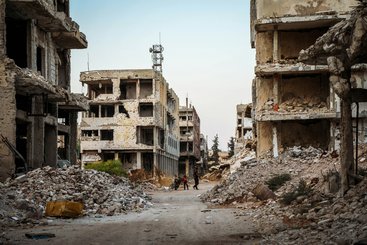Three years have passed since Myanmar’s military launched a coup that has wreaked havoc across the country, displacing more than two million people, devasting the economy, and leaving over 18 million people requiring humanitarian assistance.
It also triggered a popular uprising that has evolved into a dynamic, sustained revolution, building upon decades of struggles against the military’s violence and oppression. From the outset, much of the international community backed the movement and gradually ratcheted up targeted sanctions against the junta. As the years tick over, however, such international support has drifted towards inertia. Recent events in Myanmar and globally offer a wake-up call for the international community: seemingly intractable crises must not be left to fester.
In recent months, the revolution has made some of its most substantial territorial gains, as the military is unable to consolidate its dictatorial grip. Alongside reinforcing the potential for the revolution to succeed, it has cast further light on the inadequacies of international engagement. As the military systematically blocks humanitarian access, Myanmar’s civil society networks are leading the response, attracting widespread acclaim for their politically engaged humanitarian resistance. These exceptional efforts require far greater international support that respects the movement’s agency and autonomy.
Although there is cautious optimism that the revolution will prevail, Myanmar risks becoming entrenched as one of many neglected crises globally. This year marks a critical juncture as the revolution gains momentum; the international community must reinvigorate its engagement to support the population’s pursuit of self-determination. While the international response to Ukraine has demonstrated what can be done, lessons from elsewhere, however, suggest such a shift is not assured. Inertia is often a precursor to protracted neglect.
Neglect or negligence in Syria?
Syria serves as a poignant illustration of protracted and forgotten suffering, exacerbated by the faltering international aid system. More than 12 years of war have destroyed Syria’s civilian infrastructure and services. As of 2024, 16.7 million people require humanitarian assistance and 5.5 million are displaced within Syria. Despite ever rising needs, Syria has fallen off the radar.
The devastating earthquake in northern Syria and Türkiye in 2023 highlighted the inadequacies of the existing aid infrastructure, again exposing the limitations of the United Nations-led response. The politicisation of humanitarian assistance, exemplified by the UN Security Council’s prolonged deliberations over cross-border aid delivery and the vetoing of crucial mandates, has exacerbated human suffering and extended the conflict. The earthquake briefly drew attention to the dire humanitarian needs in the country, but the response remains severely under-resourced. It was only 38% funded in 2023, and this year, the World Food Programme is cutting the life-saving assistance that last year supported 5.5 million people.
The ongoing deprioritisation of Syria on the global stage, coupled with the rising number of global crises, is perpetuating suffering and instability in Syria. Amidst this dire backdrop, however, local humanitarian actors have continued to demonstrate remarkable resistance, especially in opposition-held northwest Syria where local civil society organisations are often the only relief agencies. Despite the humanitarian sector’s commitments to localisation, these actors remain marginalised from humanitarian leadership and decision-making, as the system continues to disempower them.
A changing landscape, but stagnant aid system in Somalia
In Somalia, the (lack of) response to years of severe drought and recent flooding further highlights the inadequacies of the international aid architecture. The insufficient and delayed response contributed towards the displacement of hundreds of thousands of displaced civilians, with approximately 43,000 excess deaths, underscoring the need for a more proactive global response.
Despite the urgent need to address the climate crisis, the Somali government continued an offensive against Al-Shabaab throughout 2023, making significant territorial gains. However, a lack of coordination between the government and humanitarian actors hampers aid delivery to liberated areas, prolonging the challenges faced by communities after years of Al-Shabaab rule. Climatic shocks and conflict have displaced millions, leading to rapid urbanisation as people pursue humanitarian assistance, yet the aid system is stagnant. Aid adaptation is urgently needed to better meet needs in urban and liberated areas to reinforce peace dividends and strengthen rural food production – the key to national resilience. Otherwise, Somalia risks remaining in perpetual crisis.
Concluding thoughts
Given the inadequacies of the Syrian response, along with the systemic neglect of Myanmar and Somalia, the principles and operations of humanitarian action are being widely questioned. Crises in Ukraine and Gaza have further intensified the fissures in the system; the former is seen as a model response in many ways, whereas the latter has witnessed perhaps the most acute and abhorrent weaponisation of aid in decades. As crises escalate and donors become ‘fatigued’, it’s local communities and civil society actors who are left to pick up the pieces: from locally led peacebuilding in Somalia, to Myanmar’s dynamic revolution, to Syrian mutual aid being the first and last line of resort.
These neglected crises also demonstrate that affected populations are not passive victims, but are instead providing critical life-saving assistance to the most difficult-to-reach people. They are also paramount to securing long-term peace and resilience. Yet, it’s been eight years since the World Humanitarian Summit; claims of ‘shifting the power’ increasingly ring hollow, let alone the sector’s growing commitment to decolonisation. Ensuring crises don’t languish in neglect means aligning and expanding support with civil society actors and affected populations. This must go beyond incremental funding increases to also supporting these actors’ efforts to end their respective crises, where political solutions must not be crowded out by humanitarian technocratic priorities.




